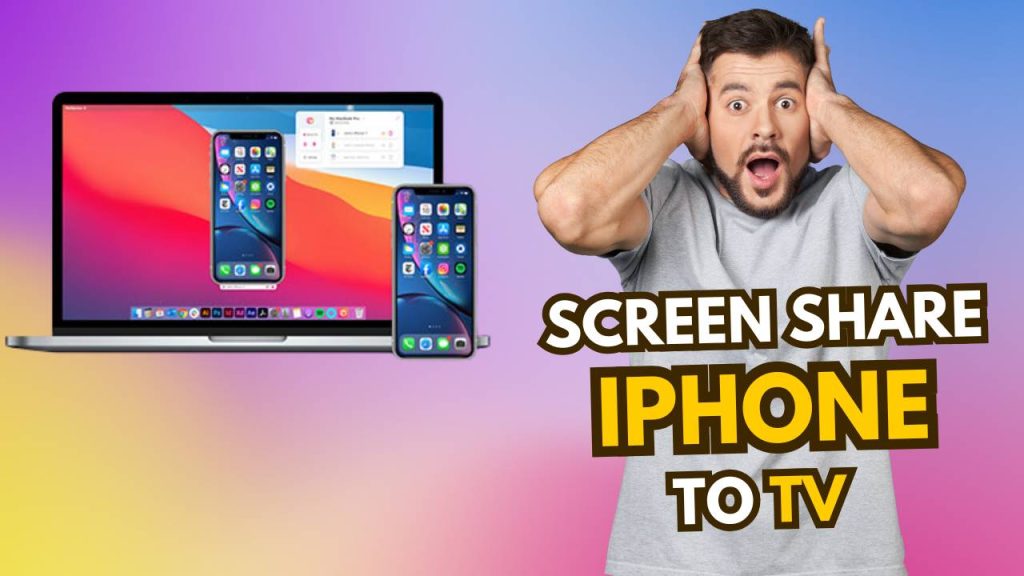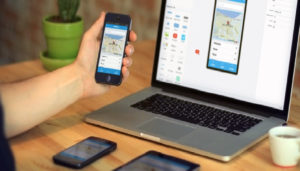In today’s digital age, screen sharing is no longer a tech luxury—it’s a daily need. Whether you’re hosting a movie night, delivering a presentation, sharing a photo album, or gaming with friends, having the ability to mirror your iPhone screen to your TV offers greater convenience and immersive experiences.
For iPhone users, there are several methods available, each suited to different types of TVs and setups. Here, I’ll walk you through the easiest ways to screen share iPhone to TV, complete with detailed steps, pros and cons, and troubleshooting tips to help you make the most of your iOS device.
Why FaceTime Screen Share Isn’t Working on iPhone and How to Fix It
Why Should You Screen Share iPhone to TV?
Screen sharing your iPhone to your TV isn’t just about watching content on a larger display—it unlocks a whole new way to interact with your device.
Want to enjoy a home theater-like streaming experience using Netflix, YouTube, or Apple TV+, or you’re collaborating on a project with colleagues in a meeting room, screen mirroring brings flexibility. It’s also ideal for gamers looking to play mobile games on a larger screen or for students attending online classes. Even viewing photos from your last trip or making video calls feels more interactive when cast to a TV. The experience becomes more social, accessible, and enjoyable.
What Do You Need to Screen Share iPhone to TV?
Before diving into screen sharing, it’s essential to understand what tools and technologies you need. Your setup may vary depending on your TV model, internet connection, and whether you prefer a wired or wireless method. The good news? Apple has made it quite simple, and with the right equipment, anyone can mirror their iPhone to a TV screen with ease.
How to Use FaceTime Screen Share on iPhone (With or Without Wi-Fi)
Here’s a more in-depth look at what you might need:
1. A Compatible iPhone
To begin with, you’ll need an iPhone that supports screen mirroring. Any iPhone model running iOS 11 or later will work flawlessly with most modern screen sharing methods like AirPlay. This includes iPhones from the iPhone 6s and newer. The newer your iPhone, the smoother your screen-sharing experience will be, especially when handling HD video or games.
Check your iOS version under Settings > General > About.
2. A Compatible TV
The type of TV you own plays a key role in determining which screen sharing method works best.
- Smart TVs from brands like Samsung, LG, Sony, and Vizio often come with AirPlay 2 support built-in, making wireless mirroring a breeze.
- If your TV doesn’t support AirPlay, don’t worry—there are third-party apps or HDMI options that let you connect your iPhone to almost any display.
For best results, consult your TV’s user manual or check the manufacturer’s website for AirPlay support.
3. A Stable Wi-Fi Connection
For any wireless screen sharing method, such as AirPlay, both your iPhone and your TV need to be connected to the same Wi-Fi network.
- Ensure that your Wi-Fi connection is fast and stable, especially when streaming HD videos or playing games.
- Avoid using mobile hotspots or public networks, as they can cause lag or interruptions during screen mirroring.
You can verify your iPhone’s Wi-Fi by going to Settings > Wi-Fi and confirming it matches your TV’s network.
4. A Lightning to HDMI Adapter (Optional for Wired Connection)
If you have a non-smart TV or prefer a wired connection for better stability, you’ll need a Lightning Digital AV Adapter (official Apple adapter recommended).
- This adapter connects to your iPhone’s lightning port and provides an HDMI output that you can plug into your TV.
- Once connected, your TV will instantly mirror your iPhone screen without the need for Wi-Fi or third-party apps.
Great option for presentations, video streaming, or when you’re in a location with limited internet access.
5. An HDMI Cable (for Wired Connection)
Along with the adapter, you’ll need a standard HDMI cable to connect the adapter to your TV’s HDMI input port.
- Choose an HDMI cable that supports 1080p or 4K resolution for the best quality output.
- Make sure the cable length is adequate for your setup, especially if your iPhone and TV are not placed close together.
Most TVs have multiple HDMI ports—use the TV remote to select the correct HDMI source once connected.
6. Optional: Third-Party Screen Mirroring Apps
If your TV doesn’t support AirPlay and you don’t want to use a cable, there are plenty of screen mirroring apps available on the App Store.
- Popular apps like ApowerMirror, LetsView, AirBeamTV, or TV Assist work with various smart TV brands over Wi-Fi.
- Some apps require you to install a companion app on your TV or use a web browser interface.
Make sure to choose a reliable app with good reviews to ensure a smooth and secure connection.
Top Methods to Screen Share iPhone in 2025 – No App Needed
Step-by-Step Way to Screen Share iPhone to TV
Method 1: Screen Share iPhone to TV Using AirPlay (Best for Apple TV & Smart TVs)
AirPlay is Apple’s proprietary wireless technology that allows users to cast content or mirror the entire iPhone screen to a compatible device. It is the most seamless and reliable method for Apple ecosystem users.
Compatible TVs:
AirPlay 2 is available on Apple TV and is also supported on many smart TVs from brands like:
- Samsung (models 2018 and newer)
- LG (models 2019 and newer)
- Sony, Vizio, and Roku TVs with AirPlay support
Step-by-Step Instructions:
Ensure Both Devices Are on the Same Wi-Fi Network
For AirPlay to work, your iPhone and TV must be connected to the same Wi-Fi network. This is essential because AirPlay relies on Wi-Fi to transmit video and audio signals wirelessly. If your devices are on different networks, they won’t be able to detect each other.
Enable AirPlay on Your TV
Go to your TV’s settings menu and enable AirPlay. This option may be found under “General Settings” or “Network Settings” depending on your TV brand. Some TVs may require a software update before AirPlay appears in the menu, so make sure your firmware is up to date.
Access the Control Center on Your iPhone
To open the Control Center, swipe down from the upper-right corner of the screen (on iPhone X and later) or swipe up from the bottom (on older iPhone models). The Control Center gives you access to quick settings, including screen mirroring options.
Tap ‘Screen Mirroring’ and Choose Your TV
Once in the Control Center, tap the Screen Mirroring button. A list of available devices will appear. Tap your TV’s name. If it’s the first time you’re connecting, your TV might display a passcode—just enter this code on your iPhone to confirm the connection.
Your iPhone Screen is Now Mirrored
The iPhone screen should appear instantly on your TV. Every action—whether swiping through apps, launching games, or watching videos—will be reflected on the bigger screen in real time. Rotate your phone to landscape for full-screen video playback.
Method 2: Use a Lightning to HDMI Adapter (Best for Non-Smart TVs)
If your TV doesn’t have smart features or AirPlay compatibility, you can still screen share your iPhone using a wired HDMI connection. This method is highly reliable and doesn’t require Wi-Fi.
What You Need:
- An Apple Lightning Digital AV Adapter (official or MFi-certified third-party)
- An HDMI cable
- A TV with an HDMI input port
How to Set It Up:
Connect the HDMI Cable to Your TV
Plug one end of the HDMI cable into an available HDMI port on your television. Most modern TVs have multiple HDMI ports, usually labeled HDMI 1, HDMI 2, etc. Make a note of which one you’re using.
Attach the HDMI Cable to the Adapter
Connect the other end of the HDMI cable to the HDMI port on the Lightning adapter. Make sure all connections are secure to ensure a stable signal transmission.
Plug the Lightning Adapter into Your iPhone
Insert the Lightning end of the adapter into your iPhone’s charging port. If you plan to mirror content for a long time, plug a charger into the adapter’s second Lightning port to keep your iPhone powered.
Switch Your TV to the Correct HDMI Input
Use your TV remote to change the input source to the HDMI port you used. Your iPhone screen should appear immediately on the TV.
Start Using Your TV as a Second Screen
Now, everything you do on your iPhone—whether it’s browsing, watching movies, or attending video calls—will be shown on your TV in real time. This method also mirrors audio, so your videos will play with sound on the TV’s speakers.
Method 3: Use Third-Party Screen Mirroring Apps (Great for Smart TVs Without AirPlay)
If your smart TV doesn’t support AirPlay, many third-party apps can help you screen share your iPhone to TV wirelessly. These apps use DLNA or mirroring protocols to send your screen over Wi-Fi.
Popular Apps Include:
- TV Cast for LG/Samsung/Sony
- AirBeamTV (paid but works great with all smart TVs)
- LetsView (free and reliable for wireless mirroring)
- ApowerMirror (offers both mirroring and file streaming)
Steps to Use a Mirroring App:
Install the Screen Mirroring App on Your iPhone
Visit the App Store and install the relevant app based on your TV brand. Some apps are designed specifically for LG, Samsung, or Sony TVs, so make sure you download the correct one.
Install the Companion App on Your TV (If Required)
Some apps, like AirBeamTV, require a TV-side application to be installed from your TV’s app store. Follow the instructions within the app to complete this step.
Connect Both Devices to the Same Wi-Fi Network
The iPhone and the smart TV must be on the same Wi-Fi network for successful connection and streaming.
Launch the App and Select Your TV
Open the app on your iPhone, and it will begin scanning for available devices. Tap your TV’s name once it appears.
Begin Screen Mirroring
Start the mirroring session by tapping “Start Mirroring” or a similar option. You may need to enable permissions or confirm a connection on the TV. Once connected, your iPhone’s screen will appear on the TV.
Method 4: Use a Streaming Device (Roku, Fire Stick, or Chromecast)
If you’re using a regular TV but have a media streaming device, you can still screen share your iPhone easily. Devices like Roku, Fire Stick, and Google Chromecast support iPhone mirroring either natively or through additional apps.
For Roku Devices:
- Go to Settings > Apple AirPlay and HomeKit on your Roku.
- Enable AirPlay, then use the iPhone’s Screen Mirroring option to connect.
Fire Stick:
- Install the AirScreen app from the Amazon App Store.
- Launch the app and open the mirroring page.
- Use iPhone’s AirPlay to find and connect to the Fire Stick.
For Chromecast:
- Use apps like Replica, Streamer for Chromecast, or Google Home.
- Connect both devices to the same network and follow the in-app instructions to begin mirroring.
These methods are ideal for people who want to extend functionality to a non-smart TV using plug-in streaming hardware.
Troubleshooting Screen Sharing Issues
Sometimes, screen mirroring may not work as smoothly as expected due to network issues, device incompatibility, or app restrictions. Below are common problems you might face when trying to screen share iPhone to TV, along with effective solutions to resolve them quickly.
1. Device Not Found
If your TV doesn’t show up when you attempt to mirror your iPhone, the most common reason is a network mismatch.
- Ensure both your iPhone and TV are connected to the same Wi-Fi network. Even being on different Wi-Fi bands (2.4 GHz vs. 5 GHz) can sometimes cause detection issues.
- Restarting both devices can help reset network discovery and resolve hidden connection glitches.
- Additionally, ensure that AirPlay or screen mirroring is enabled in your TV’s settings, as some TVs disable this by default.
- If you’re using a third-party app or streaming device, ensure that the app is up to date and the casting device (like Roku or Chromecast) is correctly configured.
2. Audio Not Transmitting
It can be frustrating when the video appears on the TV, but the sound still plays through your iPhone’s speaker.
- Check your TV’s audio input settings. Some TVs may default to internal speakers or another HDMI input that doesn’t match your active port.
- If you’re using an HDMI adapter, make sure it supports both video and audio output. Cheap or non-certified adapters may only transmit visuals.
- Adjust the iPhone’s volume while connected—sometimes, toggling the mute switch or pressing volume up can trigger audio handover.
- On smart TVs, explore the audio settings to ensure the correct speaker system (HDMI ARC, TV Speaker, or external sound system) is selected.
3. Lag or Delay
Experiencing a delay between your iPhone and TV? This can be a result of bandwidth limitations or background processes consuming resources.
- Reduce network congestion by disconnecting other devices from the Wi-Fi during mirroring, especially if others are streaming or gaming.
- Close unused apps running in the background on your iPhone to free up system resources.
- If you’re using a third-party app, opt for a premium version that often provides better optimization and less latency.
- For AirPlay users, placing the iPhone and TV closer to the router or using a 5 GHz Wi-Fi band can dramatically reduce lag.
4. Black Screen During Playback
A black screen may appear even when you’ve connected properly, often due to DRM (Digital Rights Management) restrictions enforced by some apps.
- Streaming platforms like Netflix, Disney+, and Amazon Prime may block screen mirroring for copyrighted content to prevent piracy.
- Instead of mirroring, use the app’s built-in casting feature if available. Apps like YouTube and Netflix have a “Cast” button that streams content directly to your TV using native protocols.
- Try switching to a different content source or using an HDMI adapter instead of wireless casting, as this may bypass certain DRM limitations.
- Keep both your iOS and app versions updated to avoid incompatibility issues that might also result in blank screens.
By following this guide step by step, you’ll be able to enjoy your iPhone content on your TV in the easiest and most effective way possible.
FAQs
1. Can I screen share iPhone to TV without Wi-Fi?
Yes, you can screen share without Wi-Fi by using a Lightning to HDMI adapter (also known as a digital AV adapter). This method allows a direct wired connection between your iPhone and the TV. It’s perfect for TVs that aren’t smart or when Wi-Fi isn’t available. Simply plug the adapter into your iPhone, connect it to an HDMI cable, and plug the other end into the TV.
2. How do I know if my TV supports AirPlay?
Check your TV’s settings or manual for “AirPlay” or “Apple AirPlay” support. Many modern Smart TVs from Samsung (2018+), LG (2019+), Sony, Vizio, and Roku support AirPlay 2. You can also visit the manufacturer’s website and look up your model to confirm compatibility. If it’s supported, AirPlay will usually be located under the general or network settings menu.
3. Why is my iPhone not finding my TV for screen mirroring?
This typically happens when the iPhone and TV are not on the same Wi-Fi network. Make sure both are connected to the same network and that AirPlay or the relevant screen mirroring feature is turned on in the TV settings. Restarting both devices or resetting your router can also help fix connection issues.
4. Can I screen mirror apps like Netflix or Disney+ from iPhone to TV?
Yes, but with limitations. Many streaming apps block screen mirroring due to DRM (Digital Rights Management). You may see a black screen or error when trying to mirror protected content. Instead, use the built-in Cast or AirPlay feature within the app to stream content directly to your TV.
5. What’s the difference between screen mirroring and casting?
- Screen mirroring shows your entire iPhone screen—including notifications, apps, and UI—on your TV.
- Casting only sends specific media (like a video or photo) to the TV, and you can continue using your phone for other tasks while content plays.
Mirroring is ideal for live presentations or games, while casting is better for watching videos.
6. Does screen mirroring affect video quality?
Yes, especially if you’re using a wireless method. AirPlay generally provides high-quality video, but quality may degrade with a weak Wi-Fi connection. For the best video and audio quality, especially for movies or gaming, a wired HDMI connection is more stable and consistent.
7. Can I control my TV using my iPhone while screen sharing?
In most cases, screen mirroring does not allow full TV control. You can control what’s on your iPhone (and hence what shows on your TV), but not the TV’s volume or settings directly. If you’re using Apple TV, the Apple TV Remote in the iPhone’s Control Center lets you control TV volume, playback, and menu navigation.
8. Is screen mirroring available on all iPhones?
Screen mirroring is available on most iPhones running iOS 11 or later. This includes iPhone 6s and above. You can access the feature by opening the Control Center and tapping Screen Mirroring. Older iPhones may require third-party apps or wired solutions.
9. What should I do if there’s no sound on the TV during screen sharing?
First, check your TV’s audio output settings and ensure the volume isn’t muted or set to internal speakers instead of HDMI or AirPlay. Then, check your iPhone’s mute switch and volume level. Reconnecting the devices or restarting them can often resolve audio glitches. If using an adapter, ensure it supports audio transmission.
10. Are there any free apps to help screen share iPhone to TV?
Yes! Apps like LetsView, ApowerMirror (limited free version), and TV Cast for Smart TVs offer wireless screen mirroring solutions for iPhones. These apps work best on TVs that support DLNA or Miracast. While the free versions may have limitations, they’re useful for basic screen sharing needs.




